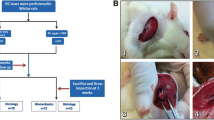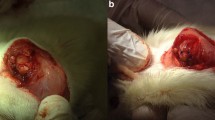Abstract
Background:
After surgical repair of chronic rotator cuff tears, healing of the repaired tendons often fails and is accompanied by high-level fatty degeneration. Our purpose was to explore the effects of polydeoxyribonucleotide (PDRN) and polynucleotide (PN) on tendon healing and the reversal of fatty degeneration in a chronic rotator cuff tear model using a rat infraspinatus.
Methods:
Sixty rats were randomly assigned to the following three groups (20 rats per group: 12 for histological evaluation and 8 for mechanical testing): saline + repair (SR), PDRN + repair (PR), and PN + repair (PNR). The right shoulder was used for experimental intervention, and the left served as a control. Four weeks after detaching the infraspinatus, the torn tendon was repaired. Saline, PDRN, and PN were applied to the repair sites. Histological evaluation was performed 3 and 6 weeks after repair and biomechanical analysis was performed at 6 weeks.
Results:
Three weeks after repair, the PR and PNR groups had more CD168-stained cells than the SR group. The PR group showed a larger cross-sectional area (CSA) of muscle fibers than the SR and PNR groups. Six weeks after repair, the PR and PNR groups showed more adipose cells, less CD68-stained cells, and more parallel tendon collagen fibers than the SR group. The PR group had more CD 68-stained cells than the PNR group. The PR group showed a larger CSA than the SR group. The mean load-to-failure values of the PR and PNR groups were higher than that of the SR group, although these differences were not significant.
CONCLUSION:
PDRN and PN may improve tendon healing and decrease fatty degeneration after cuff repair.






Similar content being viewed by others
Change history
08 July 2023
A Correction to this paper has been published: https://doi.org/10.1007/s13770-023-00558-5
References
Plate JF, Brown PJ, Walters J, Clark JA, Smith TL, Freehill MT, et al. Advanced age diminishes tendon-to-bone healing in a rat model of rotator cuff repair. Am J Sports Med. 2014;42:859–68.
Beason DP, Tucker JJ, Lee CS, Edelstein L, Abboud JA, Soslowsky LJ. Rat rotator cuff tendon-to-bone healing properties are adversely affected by hypercholesterolemia. J Shoulder Elbow Surg. 2014;23:867–72.
Oh JH, Chung SW, Kim SH, Chung JY, Kim JY. 2013 Neer Award: Effect of the adipose-derived stem cell for the improvement of fatty degeneration and rotator cuff healing in rabbit model. J Shoulder Elbow Surg. 2014;23:445–55.
Frey E, Regenfelder F, Sussmann P, Zumstein M, Gerber C, Born W, et al. Adipogenic and myogenic gene expression in rotator cuff muscle of the sheep after tendon tear. J Orthop Res. 2009;27:504–9.
Goutallier D, Postel JM, Bernageau J, Lavau L, Voisin MC. Fatty muscle degeneration in cuff ruptures. Pre-and postoperative evaluation by CT scan. Clin Orthop Relat Res. 1994;304:78–83.
Gumucio JP, Korn MA, Saripalli AL, Flood MD, Phan AC, Roche SM, et al. Aging-associated exacerbation in fatty degeneration and infiltration after rotator cuff tear. J Shoulder Elbow Surg. 2014;23:99–108.
Goutallier D, Postel JM, Gleyze P, Leguilloux P, Van Driessche S. Influence of cuff muscle fatty degeneration on anatomic and functional outcomes after simple suture of full-thickness tears. J Shoulder Elbow Surg. 2003;12:550–4.
Park JY, Lhee SH, Oh KS, Moon SG, Hwang JT. Clinical and ultrasonographic outcomes of arthroscopic suture bridge repair for massive rotator cuff tear. Arthroscopy. 2013;29:280–9.
Chung KI, Kim HK, Kim WS, Bae TH. The effects of polydeoxyribonucleotide on the survival of random pattern skin flaps in rats. Arch Plast Surg. 2013;40:181–6.
Kim HM, Galatz LM, Lim C, Haviloglu N, Thomopoulos S. The effect of tear size and nerve injury on rotator cuff muscle fatty degeneration in a rodent animal model. J Shoulder Elbow Surg. 2012;21(7):847–58.
Charousset C, Zaoui A, Bellaïche L, Piterman M. Does autologous leukocyte-platelet-rich plasma improve tendon healing in arthroscopic repair of large or massive rotator cuff tears? Arthroscopy. 2014;30:428–35.
Malavolta EA, Gracitelli ME, Ferreira Neto AA, Assunção JH, Bordalo-Rodrigues M, de Camargo OP. Platelet-rich plasma in rotator cuff repair: a prospective randomized study. Am J Sports Med. 2014;42:2446–54.
Wang A, McCann P, Colliver J, Koh E, Ackland T, Joss B, et al. Do postoperative platelet-rich plasma injections accelerate early tendon healing and functional recovery after arthroscopic supraspinatus repair? A randomized controlled trial. Am J Sports Med. 2015;43:1430–7.
Altavilla D, Squadrito F, Polito F, Irrera N, Calò M, Lo Cascio P, et al. Activation of adenosine A2A receptors restores the altered cell-cycle machinery during impaired wound healing in genetically diabetic mice. Surgery. 2011;149:253–61.
Galeano M, Bitto A, Altavilla D, Minutoli L, Polito F, Calò M, et al. Polydeoxyribonucleotide stimulates angiogenesis and wound healing in the genetically diabetic mouse. Wound Repair Regen. 2008;16:208–17.
Squadrito F, Bitto A, Altavilla D, Arcoraci V, De Caridi G, De Feo ME, et al. The effect of PDRN, an adenosine receptor A2A agonist, on the healing of chronic diabetic foot ulcers: results of a clinical trial. J Clin Endocrinol Metab. 2014;99:E746–53.
Kwon DR, Park GY, Lee SC. Treatment of full-thickness rotator cuff tendon tear using umbilical cord blood-derived mesenchymal stem cells and polydeoxyribonucleotides in a rabbit model. Stem Cells Int. 2018;2018:7146384.
Kwon DR, Park GY, Moon YS, Lee SC. Therapeutic effects of umbilical cord blood-derived mesenchymal stem cells combined with polydeoxyribonucleotides on full-thickness rotator cuff tendon tear in a rabbit model. Cell Transplant. 2018;27:1613–22.
Kwon DR, Moon YS. Synergic regenerative effects of polydeoxyribonucleotide and microcurrent on full-thickness rotator cuff healing in a rabbit model. Ann Phys Rehabil Med. 2020;63:474–82.
Giarratana LS, Marelli BM, Crapanzano C, De Martinis SE, Gala L, Ferraro M, et al. A randomized double-blind clinical trial on the treatment of knee osteoarthritis: the efficacy of polynucleotides compared to standard hyaluronian viscosupplementation. Knee. 2014;21:661–8.
Vanelli R, Costa P, Rossi SM, Benazzo F. Efficacy of intra-articular polynucleotides in the treatment of knee osteoarthritis: a randomized, double-blind clinical trial. Knee Surg Sports Traumatol Arthrosc. 2010;18:901–7.
Chung SW, Song BW, Kim YH, Park KU, Oh JH. Effect of platelet-rich plasma and porcine dermal collagen graft augmentation for rotator cuff healing in a rabbit model. Am J Sports Med. 2013;41:2909–18.
Davis ME, Stafford PL, Jergenson MJ, Bedi A, Mendias CL. Muscle fibers are injured at the time of acute and chronic rotator cuff repair. Clin Orthop Relat Res. 2015;473:226–32.
Thangarajah T, Henshaw F, Sanghani-Kerai A, Lambert SM, Blunn GW, Pendegrass CJ. The effectiveness of demineralized cortical bone matrix in a chronic rotator cuff tear model. J Shoulder Elbow Surg. 2017;26:619–26.
Killian ML, Cavinatto LM, Ward SR, Haviloglu N, Thomopoulos S, Galatz LM. Chronic degeneration leads to poor healing of repaired massive rotator cuff tears in rats. Am J Sports Med. 2015;43:2401–10.
Melamed E, Beutel BG, Robinson D. Enhancement of acute tendon repair using chitosan matrix. Am J Orthop (Belle Mead NJ). 2015;44:212–6.
Tidball JG, Villalta SA. Regulatory interactions between muscle and the immune system during muscle regeneration. Am J Physiol Regul Integr Comp Physiol. 2010;298:R1173–87.
Gumucio JP, Davis ME, Bradley JR, Stafford PL, Schiffman CJ, Lynch EB, et al. Rotator cuff tear reduces muscle fiber specific force production and induces macrophage accumulation and autophagy. J Orthop Res. 2012;30:1963–70.
Boileau P, Brassart N, Watkinson DJ, Carles M, Hatzidakis AM, Krishnan SG. Arthroscopic repair of full-thickness tears of the supraspinatus: does the tendon really heal? J Bone Joint Surg Am. 2005;87:1229–40.
Zumstein MA, Jost B, Hempel J, Hodler J, Gerber C. The clinical and structural long-term results of open repair of massive tears of the rotator cuff. J Bone Joint Surg Am. 2008;90:2423–31.
Kaux JF, Janssen L, Drion P, Nusgens B, Libertiaux V, Pascon F, et al. Vascular endothelial growth factor-111 (VEGF-111) and tendon healing: preliminary results in a rat model of tendon injury. Muscles Ligaments Tendons J. 2014;4:24–8.
Vieira MH, Oliveira RJ, Eça LP, Pereira IS, Hermeto LC, Matuo R, et al. Therapeutic potential of mesenchymal stem cells to treat Achilles tendon injuries. Genet Mol Res. 2014;13:10434–49.
Pak CS, Lee J, Lee H, Jeong J, Kim EH, Jeong J, et al. A phase III, randomized, double-blind, matched-pairs, active-controlled clinical trial and preclinical animal study to compare the durability, efficacy and safety between polynucleotide filler and hyaluronic acid filler in the correction of crow’s feet: a new concept of regenerative filler. J Korean Med Sci. 2014;29:S201–9.
Guizzardi S, Galli C, Govoni P, Boratto R, Cattarini G, Martini D, et al. Polydeoxyribonucleotide (PDRN) promotes human osteoblast proliferation: a new proposal for bone tissue repair. Life Sci. 2003;73:1973–83.
Guizzardi S, Martini D, Bacchelli B, Valdatta L, Thione A, Scamoni S, et al. Effects of heat deproteinate bone and polynucleotides on bone regeneration: an experimental study on rat. Micron. 2007;38:722–8.
Gennero L, Denysenko T, Calisti GF, Vercelli A, Vercelli CM, Amedeo S, et al. Protective effects of polydeoxyribonucleotides on cartilage degradation in experimental cultures. Cell Biochem Funct. 2013;31:214–27.
Gimbel JA, Van Kleunen JP, Mehta S, Perry SM, Williams GR, Soslowsky LJ. Supraspinatus tendon organizational and mechanical properties in a chronic rotator cuff tear animal model. J Biomech. 2004;37:739–49.
Uezono K, Ide J, Tokunaga T, Sakamoto H, Okamoto N, Mizuta H. Effect of immobilization on rotator cuff reconstruction with acellular dermal matrix grafts in an animal model. J Shoulder Elbow Surg. 2013;22:1290–7.
Liu X, Manzano G, Kim HT, Feeley BT. A rat model of massive rotator cuff tears. J Orthop Res. 2011;29:588–95.
Edelstein L, Thomas SJ, Soslowsky LJ. Rotator cuff tears: what have we learned from animal models? J Musculoskelet Neuronal Interact. 2011;11:150–62.
Mathewson MA, Kwan A, Eng CM, Lieber RL, Ward SR. Comparison of rotator cuff muscle architecture between humans and other selected vertebrate species. J Exp Biol. 2014;217:261–73.
Acknowledgements
We thank Jun Sub Jung, a research agent for valuable advices. Jung-Taek Hwang have received the National Research Foundation of Korea (NRF) Grant. This research was supported by Basic Science Research Program through the National Research Foundation of Korea (NRF) funded by the Ministry of Science, ICT (NRF-2016R1C1B2007014).
Author information
Authors and Affiliations
Corresponding authors
Ethics declarations
Conflict of interest
The authors have no financial conflicts of interest.
Ethical statement
This animal study was conducted in accordance with guidelines and approval of the Institutional Animal Care and Use Committees (IACUC) of Hallym University (Hallym-2014–22). The present study had been performed in accordance with the ethical standards in the 1964 Declaration of Helsinki. The present study had been carried out in accordance with relevant regulations of the US Health Insurance Portability and Accountability Act (HIPAA). Details that might disclose the identity of the subjects under study should be omitted. This study was presented as a podium in 2016 AAOS and as an e-poster in 2019 ISAKOS.
Trial registration
Rat muscle fixation device (KR Design Registration 30–0854878).
Additional information
Publisher's Note
Springer Nature remains neutral with regard to jurisdictional claims in published maps and institutional affiliations.
Supplementary Information
Below is the link to the electronic supplementary material.
Rights and permissions
Springer Nature or its licensor (e.g. a society or other partner) holds exclusive rights to this article under a publishing agreement with the author(s) or other rightsholder(s); author self-archiving of the accepted manuscript version of this article is solely governed by the terms of such publishing agreement and applicable law.
About this article
Cite this article
Hwang, JT., Lee, SS., Han, S.H. et al. Polydeoxyribonucleotide and Polynucleotide Improve Tendon Healing and Decrease Fatty Degeneration in a Rat Cuff Repair Model. Tissue Eng Regen Med 18, 1009–1020 (2021). https://doi.org/10.1007/s13770-021-00378-5
Received:
Revised:
Accepted:
Published:
Issue Date:
DOI: https://doi.org/10.1007/s13770-021-00378-5




